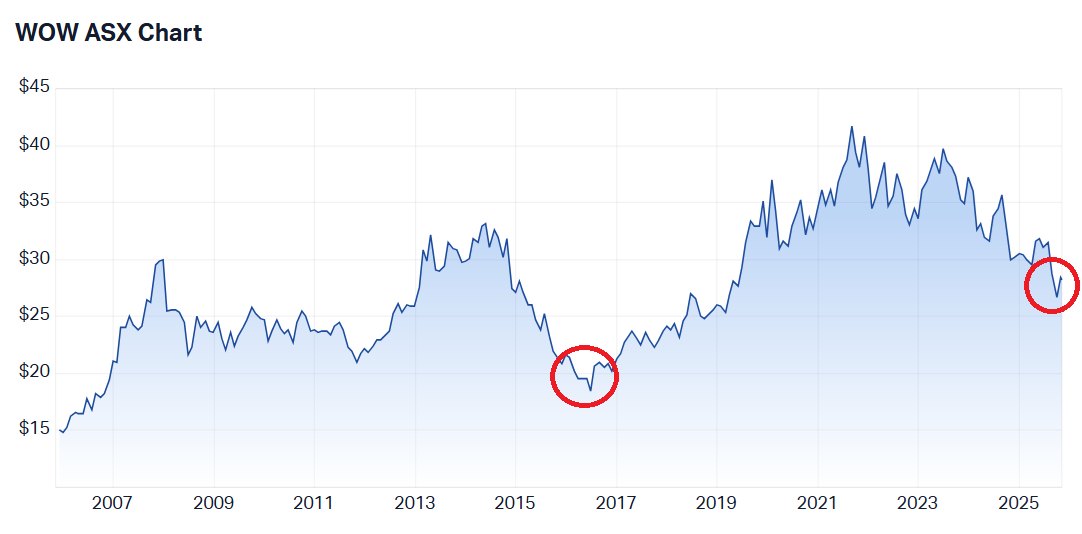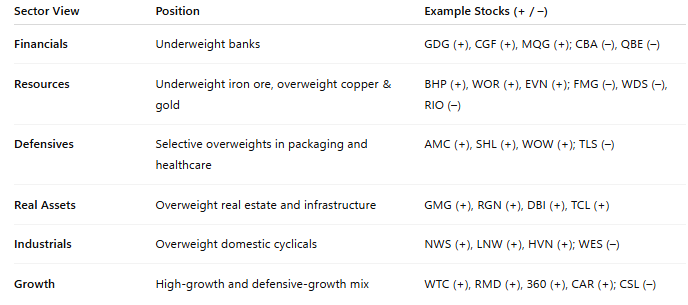Hamish Douglass bought it when no one would - now Bell Potter’s doing the same
Back in 2015 at a grand adviser roadshow hosted by Magellan Financial Group, then-chief investment officer Hamish Douglass provided what everyone expected: a portfolio update filled with the usual suspects - Mastercard, Visa, Nestlé, Microsoft… the world’s titans.
Then he revealed a name that confused even his most devout followers: Woolworths.
My first reaction: Seriously?
I was the first one to ask the question: “Hamish, I thought you invest only in quality businesses?”
Douglass, arguably in his prime as an active manager at the time, chuckled and explained that Australia had one of the most attractive grocery markets in the world in terms of margins, profitability and concentration of operators.
At the time, Woolies’ share price had collapsed from $31 to $18 in what Douglass described as “the perfect storm of mismanagement.” It was pouring money into its doomed Masters hardware chain while bleeding customers to rivals waging an all-out price war.
But he was confident it was a quality business that could turn around - a rare contrarian play for the man who popularised global mega-caps riding structural tailwinds among investors locally.
And it worked. Over the following years, Woolworths recovered spectacularly, more than doubling from those lows before Douglass finally sold out on valuation grounds.
So when a new research note put the spotlight back on Woolworths, it was hard not to think - haven’t we been here before?

A new conviction in Woolworths (ASX: WOW)
Bell Potter revealed that it rotated its exposure within the supermarket sector, adding Woolworths to its Australian Equity Core Portfolio at a 3% weight, while removing Coles (ASX: COL) and trimming Seven Group Holdings (ASX: SVW) to fund the move.
The firm’s strategists - Paul Basha, Rob Crookston and Evelyn Murdoch - said the shift reflects a view that cost-of-living pressures are easing and that defensive, non-discretionary earnings are set to outperform.
“Our investment case is predicated on a positive view of supermarkets. Supermarkets have been the first beneficiary of the cost-of-living pressures easing with shoppers choosing convenience of one destination, and increasing basket size. WOW is trading at a discount to COL which we think it can close,” they wrote.
Bell Potter believes Woolworths has reached an inflection point - sentiment has been poor, but the worst may now be behind it. The team notes that Woolworths’ first-quarter sales update marked “a line in the sand” after two years of earnings downgrades.
“[It was] the first update in a while without a downgrade, with early signs that trading momentum is stabilising,” the strategists wrote, adding “ WOW’s risk/reward has improved.”

Food for thought
Bell Potter’s case for Woolworths rests on three elements: quality, growth, and value; supported by a friendlier backdrop:
1) Quality: Woolworths remains “Australia’s #1 supermarket” with a vast store network and unrivalled supply chain efficiency, giving it “a wide competitive moat and a highly defensive, non-discretionary earnings stream.”
2) Growth: After two years of downgrades, Bell Potter believes the cycle has turned. The firm forecasts EPS growth of around 11% over the next three years, supported by margin recovery and stabilising consumer demand.
3) Value: It's stock now trades at 21.7x forward earnings, with a 3.5% dividend yield. Meanwhile, Coles is on a P/E of 25.8 and about the same yield.

“Valuation now supports the switch. WOW trades at a discount to COL and to its own history (we see scope to close part of both), while both names screen on PEGs around ~2x—attractive for large-cap domestic staples,” Bell Potter wrote.
They said if recent announcements are indeed a trough for revisions, then “the combination of multiple expansion and dividend support can drive relative outperformance.”
And while cost-of-living pressures remain, Bell Potter sees the early stages of relief as a net positive for supermarkets. As consumers begin to spend a little more per visit, supermarkets are the first to benefit.
Constructive on Australian equities
Woolworths isn’t the only defensive play on Bell Potter’s radar. The team remains generally upbeat on the ASX, but with a tilt toward staples, real assets, and quality growth rather than the traditional bank-heavy exposures.
“We remain constructive on Australian equities with a preference for mid and small caps. While global policy uncertainty continues to create volatility, we believe the domestic economy remains resilient, and Australia is relatively insulated from the worst of the global trade headwinds," the strategists said.
And while the rate-cut tailwind has faded, the strategists argue that the underlying resilience of the Australian economy justifies selective optimism.
“Rate cuts no longer appear to be the tailwind the market was expecting over the next 3-6 months, but the pause appears to be for the right reasons with the domestic economy having been quite resilient,” they said.
A snapshot of the Core Portfolio
Bell Potter’s Core Portfolio holds 32 stocks, offering a 3% dividend yield, a P/E of 22.5 times, forecast annual EPS growth of around 14% over financial years 2026–2028, and an expected return on equity of 17.3%.

Note: “+” and “–” indicate sector overweights or underweights, respectively. (Source: Bell Potter November 2025 Monthly)
2 topics
2 stocks mentioned

